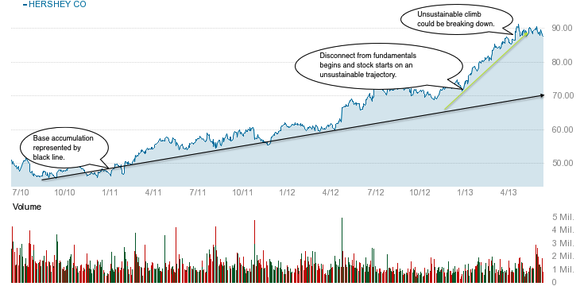It has become a well know fact that Fed intervention has spurned interest in low-paying bonds, especially with the specter of inflation around the corner. Both savers and bond investors are being forced into an equity market in which they normally would not participate. However, these groups are not putting their capital into the market in a broad sense. They are seeking out historic out-performers with good yields and low volatility. Blue chips that meet this criteria have seen large inflows over the last 12 months as a result.
In my opinion this has created a bubble, which I started pointing out here on May 9, where I explored what I termed a “blue-chip bubble.”
I urged readers to sell overpriced stocks such as Johnson & Johnson (NYSE:JNJ) at $85 and Kimberly-Clark at $103, citing historic overvaluation and unsustainable stock- appreciation trajectories.
Unfortunately, the time has come to take the pullback potential of this situation very seriously, and therefore I must point out three more stocks that have fallen victim to this blue-chip bubble.
Watch out, hot soup
Campbell Soup Company (NYSE:CPB) is normally a stock you look to own during tough times. A low beta of 0.3 means this stock historically defies volatility during market declines. But things are different this time. A long-term chart tells the whole story, from how it once performed to when things started going wrong and why a pullback is inevitable.

Chart courtesy of The Motley Fool with additional input added by author
The stock once performed in a very predictable fashion. Earnings and guidance were the catalysts for major stock moves. But in February the $36 level was broken with conviction and the stock was off to the races. It wasn’t guidance, earnings, or any major news that caused this run to the upside. Instead it can be traced to heavy inflows of capital reaching about 6 times normal volume on Feb. 14. Since then, the stock is up over 20% with absolutely no fundamentals to support such a large move over this short duration.
Campbell Soup Company (NYSE:CPB) is projected to grow only 5% over the coming year according to analysts. This makes the company a laggard in future growth with the industry itself projected to grown 14.9%. Essentially, buying Campbell Soup Company (NYSE:CPB) now means you are paying a premium price for a laggard in growth.
The upward trajectory is unsustainable. It is absolutely impossible to justify 20% moves per quarter for a company only growing quarterly earnings 2.3% year-over- year. This position will eventually stall and wait for earnings to catch up (best case scenario) or have a pullback to traditional valuations. The longer this bubble persists and the larger it becomes, the more severe the pain will be.
Should you trash this tasty treat?
Hershey Co (NYSE:HSY) is normally a delicious stock for any portfolio. But it has suffered the same fate as Campbell Soup Company (NYSE:CPB) at the hands of dividend investors who have created an overcrowded condition.
Don’t be fooled by the low beta of 0.2. This metric is based on historic performance and this current condition that Hershey Co (NYSE:HSY) faces is unlike any other in recent history. Remember it’s Fed intervention that created this blue-chip bubble situation and since we haven’t seen this level of intervention before, rules will be rewritten.
Once again a long-term chart shows the whole story. A drastic disconnect from the base accumulation rate. An unsustainable move to the upside. High valuations forming as a result. All logically followed by a correction to historically acceptable levels.

Chart courtesy of Motley Fool with additional input added by author
Now let’s throw in a key valuation metric and see how Hershey stacks up to historic valuation. Over the last five years, the highest P/E seen by this stock was 32.6. Currently Hershey Co (NYSE:HSY) is trading at a 28.4 P/E. This indicates a very poor risk/reward ratio. Pullbacks to traditional valuations are far more likely than breaking out to new all time highs, which would further exasperate this overvalued condition.
Hershey Co (NYSE:HSY)’s disconnect from fundamentals appears to be the most significant with the stock up almost 30% in the last few months, while earnings per share (EPS) are projected to grow only 10% over the coming year. This makes the company a laggard in future growth with the industry itself projected to grow EPS by 15%. As with Campbell, buying Hershey Co (NYSE:HSY) now means you are paying a premium price for a laggard in growth.
Investors don’t like Trix
General Mills, Inc. (NYSE:GIS) has been welcomed at family dining tables for decades. But the stock itself is no longer welcome in my family’s portfolio. The story remains the same – a low beta stock that has seen huge inflows and record prices bringing its valuations into question.
So let’s jump right to the chart to see the same base accumulation broken, a bubble start, and a possible top likely forming.

Chart courtesy of Motley Fool with additional input added by author
The result of this move is a P/E ratio of 17.8 which is near the five-year high P/E of 19.0. The 25% spike seen over the last few months has nothing to do with fundamentals or growth rates. It is absolutely impossible to rationalize a move of this magnitude for a stock that averages three-year revenue growth of 5.3% and three-year EPS growth of 3.4%. In fact, EPS growth for Q1 2013 vs. Q1 2012 was flat. With a forward P/E of 16.5, analysts aren’t looking for any huge earnings gains in the coming year either.
Conclusion
When stocks are cheap we are taught to buy and hold. But when those same stocks appear expensive or benefit from moves that seem unjustified by valuation or growth rates, it’s wise to consider taking profits. The door swings both ways and occasionally we must use the exit. Now is the time to exit these crowded trades and protect yourself from this blue chip dividend bubble.
The article It Might Be Time to Take Profits in Blue Chip Dividend Payers originally appeared on Fool.com and is written by James Catlin.
James Catlin has no position in any stocks mentioned. The Motley Fool has no position in any of the stocks mentioned. James is a member of The Motley Fool Blog Network — entries represent the personal opinion of the blogger and are not formally edited.
Copyright © 1995 – 2013 The Motley Fool, LLC. All rights reserved. The Motley Fool has a disclosure policy.






